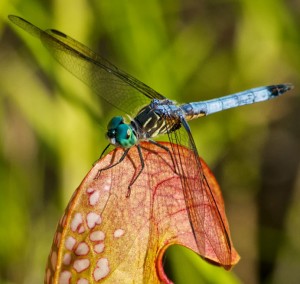Native Fauna Rapidly Discovers the Native Plant Garden
Posted in Wildlife on August 14 2013, by Thomas Andres
Thomas Andres is an Honorary Research Associate with The New York Botanical Garden.

The Native Plant Garden impresses me in many ways, but from an ecological stand point, what I see as the most exciting aspect is not what was planted or constructed. It is the birds, insects, reptiles, and amphibians who have decided to take up residency. Where did they come from and why are they here? None were intentionally introduced, but build it (or plant it) and they will come. They are indicator species of the quality of the environment.
Each species has its own story. Hummingbirds are attracted to the stunningly bright red cardinal flower (Lobelia cardinalis) and bee balm (Monarda sp.), swallowtail butterflies and bees frequent the coastal plain Joe-Pye weed (Eutrochium dubium), etc.
But then there are what I estimate to be over a dozen species of fierce predators that have little interest in the plants except to occasionally perch on them. They are superb flyers, though they are not birds, and, when young, are aquatic without wings. Some are camouflaged, especially the females, while others are brightly colored and highly territorial. All have excellent vision, at least for detecting movement.
They are the dragonflies and damselflies, known scientifically as Odonata. It is amazing what diversity already exists around the wetland in the Native Plant Garden. They are stunning to watch, but try photographing them and you may end up cursing them. Some species do occasionally land, but others, especially the larger ones, may stay aloft on the prowl all day. In flight they are constantly in search of prey while avoiding being preyed upon by other dragonflies and birds. This means their flight is very erratic and can turn on a dime by moving all four wings independently, and even hover or go backwards. The more you watch them, or photograph them, the more fascinating they become, and soon you will notice the different species and their different behaviors, and who knows? You may even become an odophile.
Here is a sampling of some of the species, at least the ones I’ve been able to capture in the lens so far.
[Not a valid template]Next time: some other denizens of the Native Plant Garden.


Hi Tom:
…your photos of the dragonflies are really amazing…it is hard to pick a fave because all of them are really incredible…went thru the slideshow three times
and finally decided that the twelve spot female with sheer wings against greenery was my fave for total beauty. Do you have one you prefer or do you love them all? Actually, I love them all:)
Thank you so much for taking all the time to get these perfect photos and share them w/us.